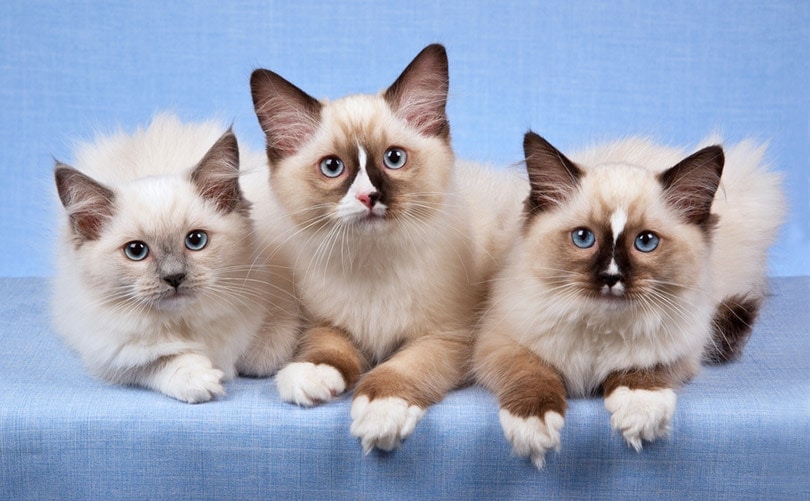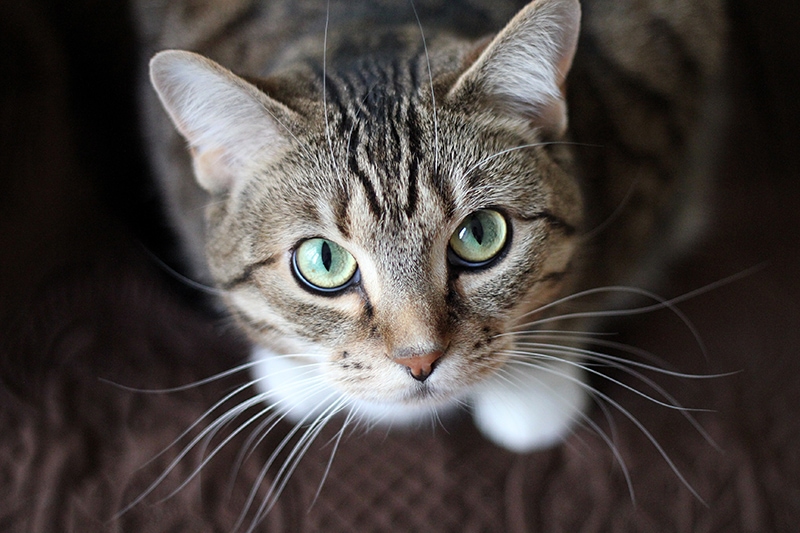How to Clean up Cat Vomit: Vet-Approved Step-by-Step Guide

Updated on
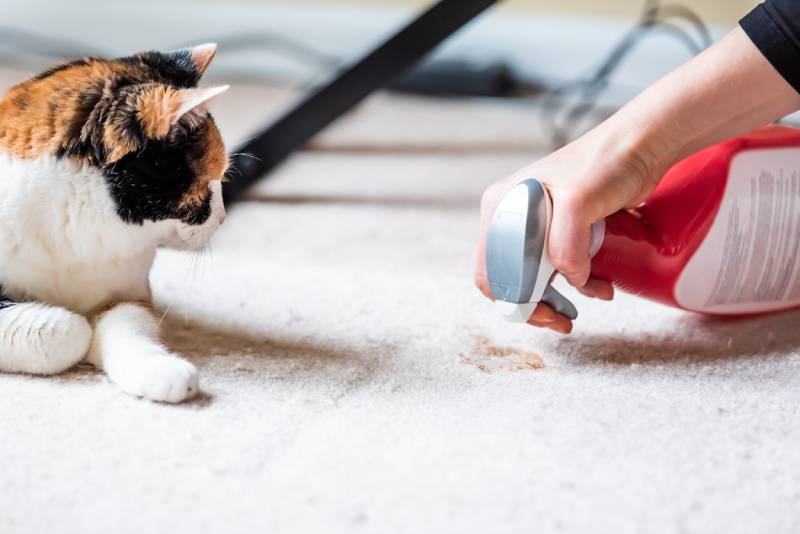
Click to Skip Ahead
Before explaining how to clean vomit up, we would feel guilt if we did not suggest the idea of contacting your veterinarian. If your cat is vomiting, no matter the underlying cause, it can lead to bigger issues.
Below, we will discuss the difference between vomiting and regurgitation so you can know when to be concerned. Then, we will help you treat those pesky vomit stains and inform you about what might cause vomiting in cats. Before explaining how to clean vomit up, the correct thing to do would be to highlight the importance of contacting your veterinarian first. If your cat is vomiting, it means there is something going on, plus it can lead to bigger issues if left untreated.
Vomiting vs. Regurgitation
If your cat has just scarfed down an entire bowl of food, they might suddenly seem ill and hack up an entire loaf just for you. If they don’t start eating it right away, you probably are rushing to the site to clean it up.
Even though this is still a mess that requires immediate attention, this is probably regurgitation. Regurgitation can happen when your cat overeats too quickly and the food comes back up passively, not being digested and with no effort or abdominal contraction. Vomit, on the other hand, tends to be more watery, partially digested, and is preceded by nausea and retching.
Often, with regurgitation, food is still well-formed and not liquid. In either circumstance, you should consult with your veterinarian.
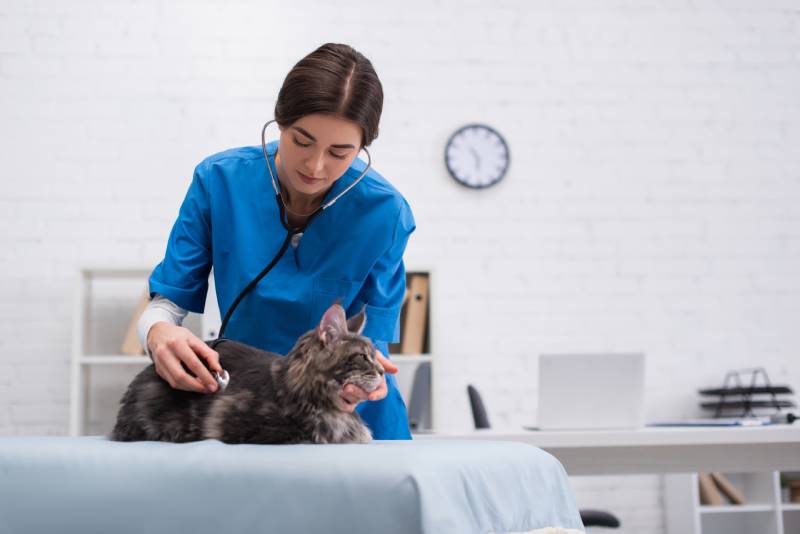
See Your Vet
With any new changes in your cat’s health, seeing your vet is a must. Even if your cat is suffering from an upset stomach, you want to ensure you get ahead of the issue. And so, if your cat is truly vomiting and you can’t identify the underlying cause, call to make an appointment today.
How to Clean up Cat Vomit on Carpet or Fabrics
Cleaning up vomit from wood or tile will be relatively easy. All you need is paper towels and a cleaner to remove the mess. However, when vomit gets into the fibers of carpet, it can be very problematic.
Not only is cat vomit a highly unpleasant smell, but it also is incredibly difficult to remove once it adheres to a surface. So, follow these methods to remove the vomit from carpets and fabrics.
1. Use an Enzyme Spray
One of the most effective ways to clean up cat vomit is with an enzyme cleaner, but finding one that works can be challenging. How they work is through a chemical process that effectively neutralizes odors and stains. In most cases, this type of spray will work on carpets, floors, fabrics, furniture – pretty much any surface you can think of!
Not only will it clean up vomit but also drool, urine, and feces. To use it, spray it on a discreet area to make sure it doesn’t alter the color. Then, just spray it on the vomit stain and let it sit for 10 minutes, then blot it with a clean rag and let the area dry.
Our favorite enzyme cleaner is the Hepper Advanced Bio-Enzyme Pet Stain & Odor Eliminator Spray. It's our product, and we love it so much, we just have to share. It permanently removes the very worst smells and stains (yes, everything you can imagine!), and we offer a 100% satisfaction guarantee!
- ADVANCED ENZYMATIC CLEANER - Penetrates the most stubborn smells and stains at the deepest molecular...
- FOR ANY MESS, ON ANY SURFACE - This pet odor eliminator cleans your carpets, floors, furniture,...
2. Mix up a Powerful Cleaner Naturally
- ¼ teaspoon powerful dish soap
- 1 tablespoon white vinegar
- 1 cup warm water
You can put it in an old spray bottle or bowl to apply. Once you have mixed up this concoction, use an old cloth and gently blot the area. Continue to clean the cloth in between until you completely remove the stain. Then, use a paper towel to draw out the liquid in the carpet.
3. Vacuum the Area
No matter which type of cleaner you use, once the area dries completely, it’s time for the vacuum. Make a few passes across the area and remove any remnants. Once you finish up—voila! Mission accomplished.

4. Wash Other Affected Materials
If your clothes or fabrics are soiled, wash them in the washing machine promptly at the hottest temperature that is safe for the clothes (check the tag inside the clothing if you’re unsure). Cat vomit can be laden with bacteria, and you want to make sure you remove the stain as well as the bacteria.
What Could Cause a Cat to Vomit
You might be wondering what in the world prompted your cat to vomit in the first place. It is important to try to differentiate between vomiting and regurgitating because they are caused by different reasons. You will also need to watch your cat closely for the severity and frequency of the vomiting, as well as for any additional signs of disease. The primary concern if your cat is vomiting and stops eating and drinking is dehydration.
If your cat continues to vomit, they start losing fluids and quickly become dehydrated and very ill. So, regardless of the underlying condition, it’s best to make an appointment with your veterinarian if your cat vomits more than once. This could signal anything from toxicity to long-term health conditions.
Some of these issues may be very temporary and easy to fix, while others will be more complicated, costly, and difficult to treat. We wanted to discuss some of the main things to look for.
1. Intestinal Parasites
Intestinal parasites might be an easy thing to treat, but they can be quite difficult to pin down. After all, if your cat is going to the vet with extreme gastrointestinal upset, it can be a little complicated to find out worms are the only culprit.
- Dull coat
- Diarrhea
- Mucous in stool
- Bloody feces
- Appetite loss
- Pot-bellied appearance
Luckily, if you find out that parasites are the culprit, you can get your cat treatment for them at your vet’s office or over the counter.
2. Viral or Bacterial Infection
Cats are susceptible to several bacterial and viral infections. Thanks to the introduction of vaccinations, many viral infections in cats are avoided entirely or significantly decreased.
- Salmonella
- Campylobacter
- E. coli
Viral infections, like feline panleukopenia, can be a little more complicated and require hospitalization and sometimes intensive treatment. The good news is that it is usually preventable through common vaccines.
3. Toxicity
Possibly far scarier, another culprit of profuse vomiting could be toxicity of some kind. Toxicity can vary from mild to life-threatening, so prompt treatment is necessary.
- Sluggishness
- Seizures
- Heavy breathing
- Diarrhea
- Drooling
- Unsteady gait
If your cat is suffering from a food or environmental toxin, vet treatment will be necessary.
4. Hairball
It may sound simple, but hairballs sure can be the cause of some vomiting episodes. If this is the case, your cat will probably hack until they pass one of the hairballs, and then they should trot about their merry way.
Long-haired cats and excessive groomers often have more of a problem with hairballs than many others, though any cat can get them.
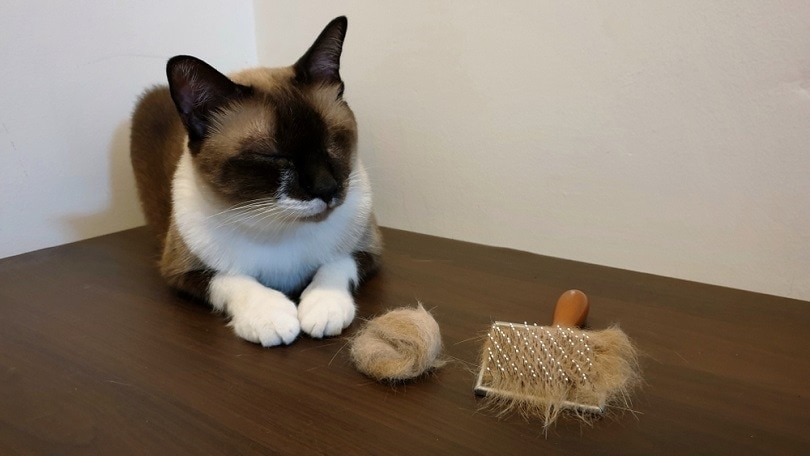
5. Constipation
That’s right. Constipation can be so bad that sometimes, it can cause your cat to vomit. If you haven’t been monitoring their bathroom habits, the litter box is a good place to check. They can tell you all sorts of things about your cat’s house, including how often they are going number two.
6. Food Allergy
Food allergies can sometimes cause cats to vomit. That shouldn’t be the first line of thought regarding a cat vomiting profusely, as you want to rule out other acute issues first.
However, a food allergy can severely impact your cat’s overall health. If they have prolonged exposure to an allergen, it can cause them to display a laundry list of signs. They can be pretty miserable.
- Diarrhea
- Weight Loss
- Overgrooming
- Hairloss
- Frequent skin infections
- Dull coat
- Lack of appetite
If you suspect an allergy in your cat, it’s best to get them in front of the vet immediately so that you can get to the root cause and begin treatment. Cats that have their allergies managed can reduce signs of illness significantly.
7. Endocrine Disease
Your cat can suffer from different hormonal disorders, such as diabetes or hyperthyroidism. These chronic problems can cause a myriad of signs that can affect various organs in your cat’s body.
Since they can impact so much of your cat’s system, side effects depend on the root cause. If vomiting is chronic, speedily get to the underlying cause so treatment can commence.
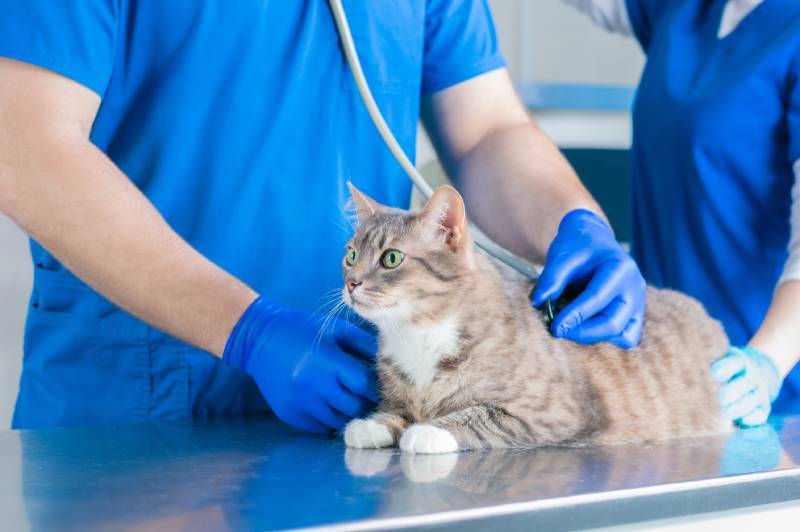
Conclusion
Spending time removing vomit from your carpets and fabrics might be pretty nasty, but it’s a manageable experience. Just a few ingredients you have on hand will combat the smell and swipe the stain.
Generally, vomiting is transient and will soon pass. Your cat might have an upset stomach, or it could also signal a bigger issue. To be safe, it’s best to get your cat to the vet so they can have a routine examination.
See Also:
Featured Image Credit: Kristi Blokhin




